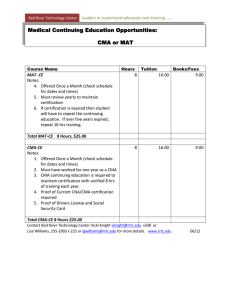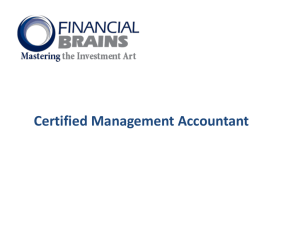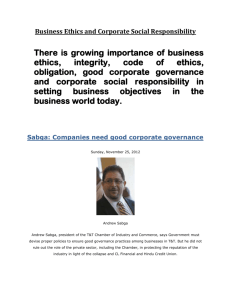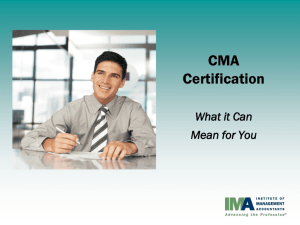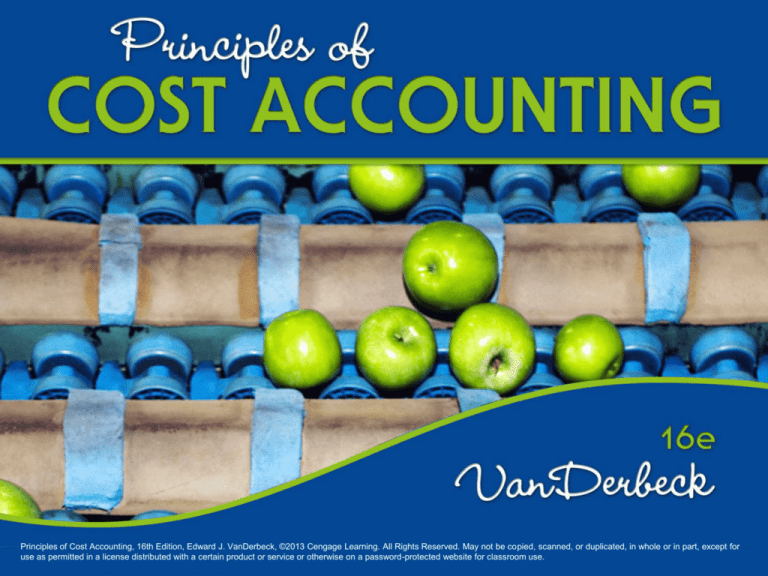
Principles of Cost Accounting, 16th Edition, Edward J. VanDerbeck, ©2013 Cengage Learning. All Rights Reserved. May not be copied, scanned, or duplicated, in whole or in part, except for
use as permitted in a license distributed with a certain product or service or otherwise on a password-protected website for classroom use.
Chapter 1
Introduction to Cost
Accounting
Learning Objectives
Explain the uses of cost accounting
information.
Describe the ethical responsibilities and
certification requirements for management
accountants, as well as corporate
governance.
Learning Objectives (cont.)
Describe the relationship of cost accounting
to financial and management accounting.
Identify the three basic elements of
manufacturing costs.
Illustrate basic cost accounting procedures.
Distinguish between the two basic of cost
accounting systems.
Illustrate a job order cost system.
What is Cost Accounting?
• Cost Accounting provides the detailed
information that management needs to
control current operations and plan for the
future.
• Management uses this information to
decide how to allocate resources to the
most efficient and profitable areas of the
business.
Types of Businesses that use
Cost Accounting
• All types of business entitiesmanufacturing, merchandising, and
service businesses-require cost
accounting information systems to track
their activities.
• Manufacturers convert purchased raw
materials into finished goods by using
labor, technology, and facilities.
Types of Businesses that use
Cost Accounting
• Merchandisers purchase finished goods
for resale.
• For-profit service businesses, such as
health clubs, accounting firms, and NHL
hockey teams, sell services rather than
products.
Types of Businesses that use
Cost Accounting
• Not-for-profit service agencies, such as
charities, governmental agencies, and
some health care facilities, provide at little
or no cost the user.
The Nature of the
Manufacturing Process
• The nature of the manufacturing process
requires that the accounting information
systems of manufacturers be designed to
accumulate detailed cost data relating to
the production process.
• The manufacturing process requires the
conversion of raw materials into finished
goods through the use of labor and other
factory resources.
The Nature of the
Manufacturing Process
• Product quality is as important a
competitive weapon as control in the
global arena.
• ISO 9000 standards requires that
manufacturers have a well-defined quality
control system, and that they consistently
maintain a high level of product quality.
Uses of Cost Accounting
Information
• Principles of cost accounting have been
developed to enable manufacturers to
process the many different costs associated
with manufacturing and to provide built-in
control features.
Uses of Cost Accounting
Information
• The information produced by a cost
accounting system provides a basis for
determining product costs and selling
prices, and helps management to plan and
control operations.
Uses of Cost Accounting
Information
• Cost Accounting Information is used for:
- Determining Product Costs and
Pricing
- Planning and Control
Professional Ethics, CMA
Certification, and Corporate
Governance
• IMA – Institute of Management
Accountants
• CMA – Certified Management Accountant
certificate
• Sarbanes-Oxley Act of 2002 – written to
protect shareholders and stakeholders by
improving corporate governance
Professional Ethics, CMA
Certification, and Corporate
Governance
• Corporate governance is the means by
which a company is directed and
controlled.
• Key elements of Sarbanes-Oxley
CEO and CFO certification of
financial statements
Establishment of Public Company
Professional Ethics, CMA
Certification, and Corporate
Governance
• Accounting Oversight Board (PCAOB)
• Prohibits a public accounting firm from
providing non-auditing services to a
company it audits.
• Requires that a company’s annual
report contain an internal report
Professional Ethics, CMA
Certification, and Corporate
Governance
• Board of Directors’ responsible for
hiring, compensating, and terminating
the audit firm
• Severe criminal penalties for the
destruction or alternation of business
documents and retaliation against
“whistleblowers”
Relationship of Cost
Accounting to Financial and
Management Accounting
• Financial accounting meets the needs of
investors, creditors, and other external
users of financial information.
• Management accounting focuses on
historical and estimated data that
management needs to conduct ongoing
operations and do long-range planning.
Relationship of Cost
Accounting to Financial and
Management Accounting
• Cost accounting includes those parts of
financial and management accounting
that collect and analyze cost
information.
Relationship of Cost
Accounting to Financial and
Management Accounting
Relationship of Cost
Accounting to Financial and
Management Accounting
Relationship of Cost
Accounting to Financial and
Management Accounting
Elements of Manufacturing
Costs
• Manufacturing or production costs are
classified into three basic elements: (1)
direct materials, (2) direct labor, and (3)
factory overhead.
Illustration of Accounting for
Manufacturing Costs
Cost Accounting Systems
• To provide management with data needed
for effective cost control, two basic types of
cost accounting systems have been
developed:
- Process Cost System
- Job order Cost System
• Both systems are used to gather cost data
and to allocate costs to goods
manufactured.
Cost Accounting Systems
• In a job order cost system the output
consists of special or custom-made
products.
• The focus is on determining the cost of the
individual specific job.
Cost Accounting Systems
• A process cost system accumulates costs
for each department or process in the
factory.
Cost Accounting Systems
• Some companies use both a job order and
a process cost system.
• A standard cost system, which is not a
third system can be used with either a job
order of a process cost system, uses
predetermined standard costs to furnish a
measurement that helps management
make decisions regarding efficiency of
operations.
Illustration of a Job Order
Cost System
• With a job order cost system, costs are
accumulated by job.

